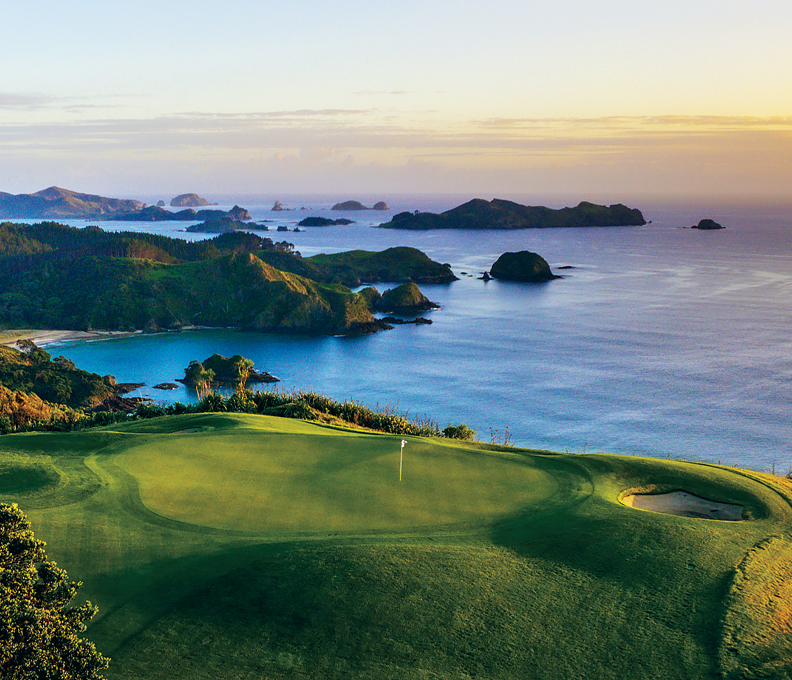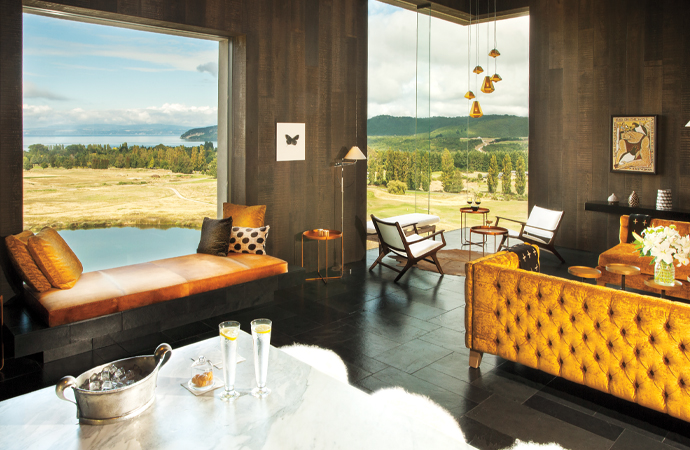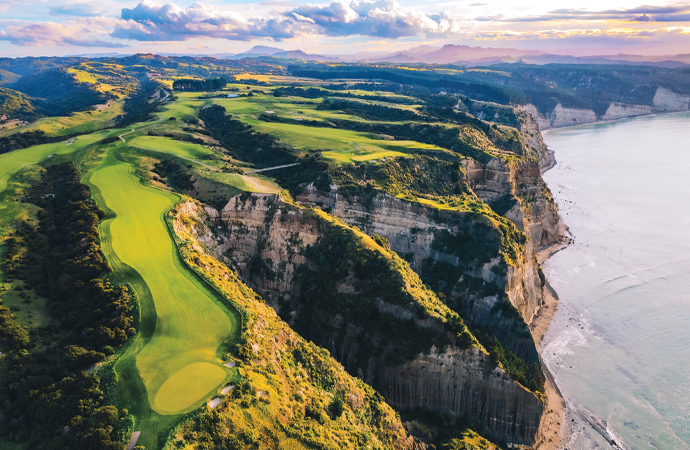New Zealand’s North Island Offers a Bounty of Breathtaking Golf
The Pacific nation is one of the world’s best weeklong golf destinations
by Jeff Wallach
September 19, 2024

Rosewood Kauri Cliffs, Matauri Bay / Photo: Courtesy of Ricky Robinson
When you look down on the North Island of New Zealand from the air, the land appears well-suited for three things: sheep, hobbits and golf. We’ll focus here on the Pacific nation as one of the world’s best weeklong golf destinations.
Begin your adventure at Rosewood Kauri Cliffs, where architect David Harman made 42 visits from Florida to craft a layout that presents a greatest hits of design. One moment it’s a Carolina low-country track playing through wetlands before climbing to windswept, ocean-view ridgetop holes that recall Hawaii’s Kapalua. At other times it elicits memories of rolling Irish hill country dotted with sheep before morphing into mountain golf like you’d find in Colorado, where shots carom off hills and steep slopes. The par threes here are particularly heroic, all requiring carries over ravines. It adds up to a harmonious amalgam of terrific shot challenges melded into a balanced whole.
Kauri Cliffs is found at the Robertson Lodges property of the same name. Pursue scuba diving, big-game fishing, sailing and other sports; hike to waterfalls, the unmissable Pink Beach and an 800-year-old kauri tree; and otherwise enjoy the upscale tropical plantation styling, thoughtful room appointments (even the bathroom hooks are finished in leather) and five-course tasting menus with wine pairings each night. Kauri offers the pinnacle of high-end golf resort experiences.
Traveling south a couple of hours will land you at the rolling dunelands of Te Arai Links, distinguished by clean, minimalist architecture and design evident in the luxe lodgings and two courses that are maximalist in terms of fun, challenging seaside golf. There’s no way to avoid comparisons to Oregon’s Bandon Dunes here: The architects of Te Arai’s courses both designed layouts at Bandon; the property sits a long way from anywhere on the Pacific coast; and it offers pure links golf with few other activities. Both resorts were also created by wealthy American visionaries on two of the world’s best sites for the game.

Ric’s Restaurant at Te Arai Links, Tomarata / Photo: Courtesy of Te Arai Links
Te Arai’s South Course romps across natural sand hills with views of the ocean and Little Barrier and Hen and Chicken islands, with no bunkers but vast waste areas. The focus is on enjoyment, and management doesn’t even set out championship tees, figuring that anyone good enough to play from them will know where to look. Owners empowered architects Bill Coore and Ben Crenshaw to accomplish three things: create the best course possible, make the golf fair and fun, and design a walkable layout that can be played in less than four hours.
While Tom Doak’s North Course seems far more caffeinated than the South, director of golf Jon McCord says it plays a mere half shot harder thanks to “rollicking and frolicking greens.” Doak sneaks in bailout areas (sometimes hidden) to safely collect errant shots, but greens may prove more complicated than elf politics in Rivendell. Red sandstone rock faces, grass-faced bunkering and pockets that alternate between inland pine forests and coastal sand blowouts further define this venue. After golf, head to The Playground, a vast 12-to-18-hole putting course perfect for settling a few bets and providing one more excuse to stroll among the effervescent scenery.
Traveling 90 minutes south to Alister MacKenzie’s Titirangi golf club will take you back a century in time. This old-school private British-style club delivers bracing formality with its trophy cases and a dining room that serves a perfect savory lunch pie and a good pint. MacKenzie’s original sketches for the course show bold lines depicting the route of attack for scratch players and dotted lines indicating alternative paths for higher handicaps. MacKenzie, who designed camouflage during WWI, wrote, “There is an extraordinary resemblance between what is now known as the camouflage of military earthworks and golf-course construction. The chief object of every golf architect or greenkeeper worth his salt is to imitate the beauties of nature so closely as to make his work indistinguishable from nature itself.”
According to director of golf (and MacKenzie aficionado) Doug White, trees have encroached on MacKenzie’s original layout over many years and the club is patiently restoring it to a more original condition. The 12th hole demonstrates what a crazy green looked like during the golden age of golf architecture (before Doak got a bulldozer). Holes wind naturally through a jungle of ferns, palms and native bush, and an often hidden creek crosses the closing holes six times. Little earth was moved in creating the understated routing, and few holes are visible from other holes. Many shots must be hit precisely over gullies and ample fairway bunkering, and positioning is paramount off the tees, including employing specific angles of attack—a MacKenzie trademark. The four par threes each play in a different direction. The walkable course has hosted numerous New Zealand Opens and has been listed among Golf Digest’s Top 100 Courses Outside the U.S.
Continuing three hours south of Titirangi, you’ll discover the paradise of Kinloch Manor & Villas, a Jack Nicklaus layout built on pumice and sand. Director of golf and head pro Tom Long describes it as the toughest in New Zealand and “brutal off the back tees.” Here, balls must complete their flights toward the putting surfaces or you’ll be scavenging in the fescue or hitting out of all manner of overamped bunkers below, above but seemingly never near the greens. A preponderance of the ample trouble lies short, so take more club on this muscular American-style layout. Several blind shots increase the difficulty and Long encourages the “Irish drop,” whereby players take a one-stroke penalty for a lost ball and move along.

Bar at Kinloch Manor & Villas, Taupo / Photo: Courtesy of Kinloch Manor
The first green indicates further mayhem to come. Aiming poles are helpful, whereas water hazards prove not to be. And forget about flat lies entirely as Kinloch was built during Nicklaus’ vindictive period. There aren’t many trees on this parkland layout overlooking Whangamata Bay, but the few present are put to good use in framing greens and forcing players to shape certain shots. Many decent but not great strikes will be duly punished, but low handicappers will appreciate the challenges and no doubt loudly celebrate successes. The elevated tenth tee offers a panoramic view of everything nearby, including a wide, welcoming fairway. Seventeen presents a downhill par three protected by the ice wall from Game of Thrones. And the 18th brings water into play on a par five crouching beneath steep green hills. Remember throughout that fescue equals death.
Possibly the best part of Kinloch is the tony lodging perched high above the course with great views of golf and the bay beyond. The memorable dining and public rooms feature African patterns, leather and copper, with daybeds and cushions located beside windows and fireplaces scenting the spaces. Guest rooms spacious and luxurious.

Hole 15 at Cape Kidnappers, Te Awanga / Photo: Courtesy of Cape Kidnappers
Heading farther south and to the east coast you’ll reach Rosewood Cape Kidnappers, sister property to Kauri Cliffs and equally exquisite. Doak built the epic golf course on fingers of cliffs tilting in ridges toward the sea on a vast private property still operating as a working farm—which is echoed in the design theme throughout. The golf is firm, fast and windy, playing over tea trees and between ravines, with the ocean 500 feet below. By the second hole you’ll recognize you’re in the hands of a master architect.
Do your scoring early here, with three par threes on the front side and the final ones coming at holes 11 and 13, after which the course ramps up to a massively difficult final three holes on the back—and if you’re walking, best to have a Red Bull in your bag to get you up the hills. While the variety of holes is entertaining, they also succeed like an ensemble cast in creating a coherent drama. The most difficult hole may be number 15, named Pirate’s Plank—the fairway narrows out onto a plateau for about a gazillion yards. Golf shop manager Matt Hamill says that if you take a nine but finish with the same ball you’ve done well.
Lodgings feature airy rooms tucked into the forest close to a heated outdoor pool, Jacuzzi and spa and looking out across the vast landscape. The main lodge—including the most beautiful grain silo you’ve ever sipped local wine in—encompasses cozily designed rooms decorated with farm implements and artwork and serves masterful food.
On your way to the artsy small capital city of Wellington, at the southern end of the island, stop in at Paraparaumu Beach Golf Club to experience what may be the most unadulterated fun offered by any of New Zealand’s golf layouts. Designed in 1949 by Alex Russell, a partner of MacKenzie’s, it stands as one of the last golden age golf courses built worldwide. The terrain consists of pleasing grassy humps and bumps, with no earthworks and a mere 34 sculpted bunkers, many with lovely revetted faces. In the best British tradition, the course has 924 members but offers friendly outside play to all.
Former general manager Leo Barber, who recently stepped down after 18 years, describes the natural topography thus: “Dig a hole here, you have a bunker. Mow some grass and you have a fairway.” And if you find yourself in the ample fescue rough you have a good chance of finding more golf balls than you hit in there. The course features clever short par fours, and number eight is one of the best, a severe dogleg left that gives you the choice between, as Barber says, “the line of instinct versus the line of charm.” He adds, “The routing ducks and dives around a bit so you never have the same wind for more than two holes.” Still, it’s not about individual holes here—although there are many standouts—but more the overall feel of the grassed terrain under your feet and the pure pleasure of running the ball along perfect well-coiffed golfing grounds. If you want to emulate Tiger Woods after golf, book one of the two rooms at Greenmantle, set in an ancient forest a few miles away. But not to worry: The trees will not begin talking.




